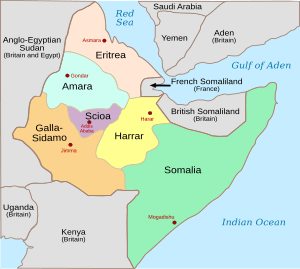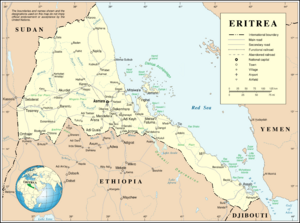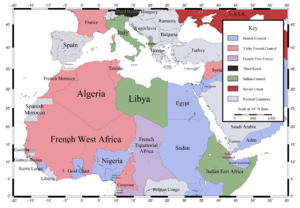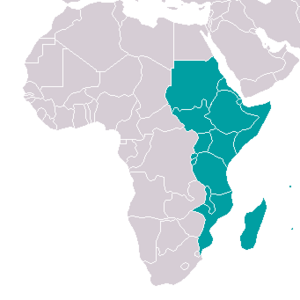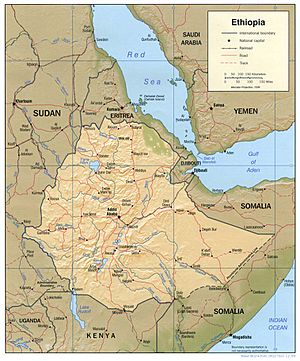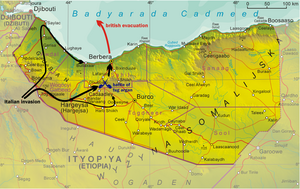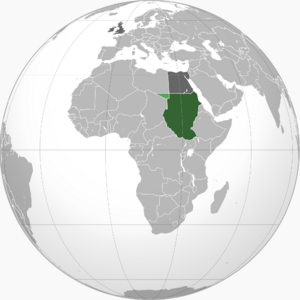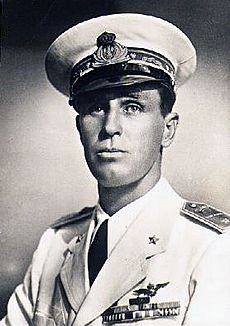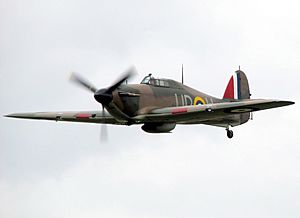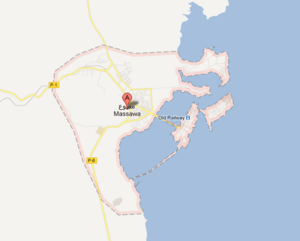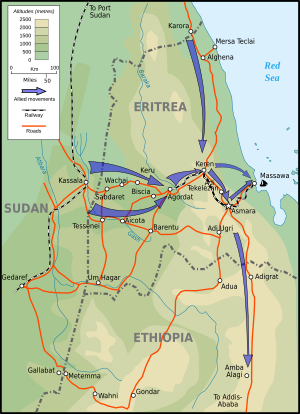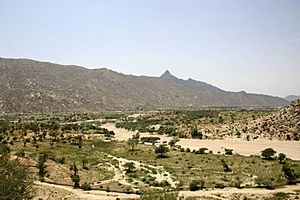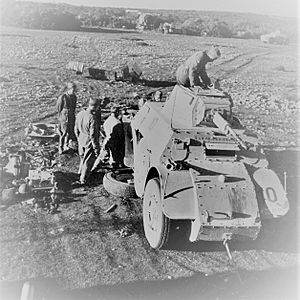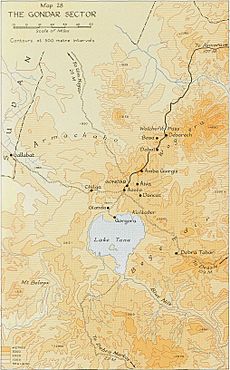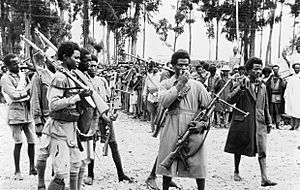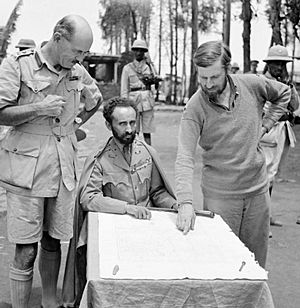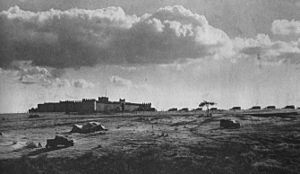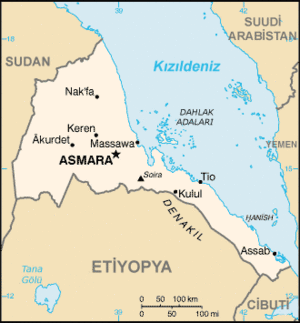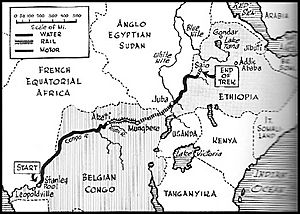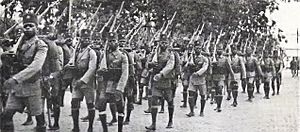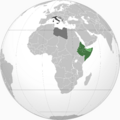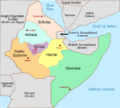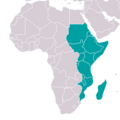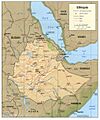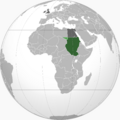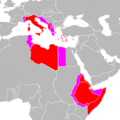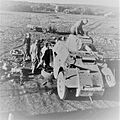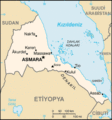East African campaign (World War II) facts for kids
Quick facts for kids East African campaign |
|||||||||
|---|---|---|---|---|---|---|---|---|---|
| Part of Mediterranean and Middle East theatre of the Second World War | |||||||||
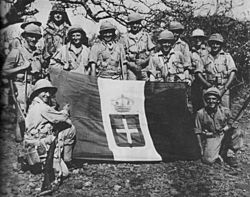 South African soldiers with a captured Italian flag, 1941 |
|||||||||
|
|||||||||
| Belligerents | |||||||||
|
|
||||||||
| Commanders and leaders | |||||||||
| Strength | |||||||||
|
~115,000 troops
2 cruisers 2 destroyers 2 auxiliary cruisers |
~250,000 troops
63 tanks 126 armoured cars |
||||||||
| Casualties and losses | |||||||||
| British Empire: 1,154 killed 74,550 wounded or sick 138 aircraft Ethiopia: 5,000 killed Belgium: 462 killed Free France: 2 aircraft |
Italy: 16,966 killed 25,098 wounded or sick ~230,000 captured 250 aircraft |
||||||||
| AOI casualties exclude Giuba and the eastern front | |||||||||
The East African campaign was a series of battles fought in East Africa during World War II. It took place between June 1940 and November 1941. The main fighters were the Allies of World War II, especially from the British Empire, against Italy and its colony, Italian East Africa.
The British Middle East Command led the Allied forces. These included soldiers from the United Kingdom, South Africa, British India, and various African colonies. They were joined by the Force Publique from the Belgian Congo, Ethiopian resistance fighters called Arbegnoch, and a small group of Free French soldiers.
Italy's forces in Italian East Africa were cut off from supplies once the war began. This was because Britain controlled the Suez Canal. The campaign started with Italian air raids in June 1940. The fighting continued as Allied forces pushed the Italians back through Somaliland, Eritrea, and Ethiopia. The last major Italian forces surrendered in November 1941 after the Battle of Gondar. However, some Italian groups continued a guerrilla war until September 1943.
This campaign was the first big Allied victory in World War II. It helped clear the Red Sea for Allied ships, making it easier to send supplies to Egypt. Most of the British and Commonwealth troops then moved to North Africa to fight in the Western Desert campaign.
Contents
Why the War Started
Italy's East African Empire
In 1936, Italy's leader, Benito Mussolini, created Italian East Africa (AOI). This new colony was formed from Ethiopia, which Italy had recently conquered, and its older colonies of Italian Eritrea and Italian Somaliland.
When Italy declared war on Britain and France in June 1940, its forces in East Africa became a threat. They could attack British and French colonies nearby. Italy's entry into the war also made it dangerous for Allied ships to sail through the Mediterranean Sea. It also threatened important shipping routes along the coast of East Africa and through the Red Sea to the Suez Canal.
Italy's military leaders had planned for a war later, after 1942. So, in the summer of 1940, Italy was not fully ready for a long war or to occupy large parts of Africa.
Italian Forces in East Africa
Amedeo, Duke of Aosta, was the top commander for Italy in East Africa. By June 1940, he had about 290,000 soldiers. After calling up more people, this number grew to over 370,000 troops by August.
Most of Italy's soldiers in East Africa were local troops called Askari. These were led by Italian officers. Some of the best units were the Eritrean battalions. They were well-trained for fighting in the colonies. The Italian forces had many machine guns, some tanks, and armored cars. However, they were cut off from Italy and quickly ran low on supplies, especially ammunition.
Italian Air Force
Italy's air force in East Africa had about 323 aircraft in June 1940. Most of these were bombers. They also had some fighter planes. Many of these planes were older models. The air force had experienced pilots, including some who had fought in the Spanish Civil War.
They had enough fuel and bombs to start, but spare parts were hard to get. Many planes had to be taken apart to keep others flying. This meant their air power would not last long without new supplies.
Italy's navy in the Red Sea was based at Massawa in Eritrea. This port was important because it connected to Axis-controlled Europe. The navy had seven older destroyers and eight modern submarines.
These ships were in a good position to attack Allied convoys (groups of ships) sailing through the Red Sea to the Suez Canal. However, their supplies were meant to last only about six months. The submarines were supposed to stop British ships from using the Red Sea route.
British Forces in the Middle East
Britain had soldiers in Egypt to protect the Suez Canal and the Red Sea route. This route was very important for connecting Britain with its territories in Asia. General Archibald Wavell was in charge of the new Middle East Command. He was responsible for defending Egypt and coordinating military actions.
Wavell's main goal was to defend Egypt and the Suez Canal. Taking over Italian East Africa was his second priority. He planned to gain control of the Red Sea quickly. He also planned to invade Ethiopia once he had enough troops.
East Africa Force
The British East Africa Force was set up to defend North-East Africa. In Sudan, about 8,500 troops and 80 aircraft guarded the long border with Italian East Africa. These included the Sudan Defence Force and later, Indian infantry divisions.
In Kenya, the King's African Rifles and South African units were stationed. By the end of 1940, about 27,000 South African soldiers were in East Africa. Troops from Nigeria and the Gold Coast (now Ghana) also joined the force.
Ethiopian Resistance
The British also supported Ethiopian resistance fighters, known as the Arbegnoch. These groups were fighting against the Italian occupation of Ethiopia. In June 1940, Emperor Haile Selassie, who had been forced out by the Italians, arrived in Sudan. He met with British commanders to plan how to take back Ethiopia.
A special British unit, called Mission 101, was formed to help the Ethiopian resistance. They trained the Arbegnoch in guerrilla warfare. This helped them attack Italian forces and disrupt their movements.
Fighting in the North, 1940
Italian Invasion of British Somaliland
On August 3, 1940, Italian forces invaded British Somaliland. They had two colonial brigades, tanks, armored cars, and air support. The British garrison was much smaller. The Italians quickly captured towns like Zeila and Hargeisa. This cut off the British from French Somaliland.
Battle of Tug Argan
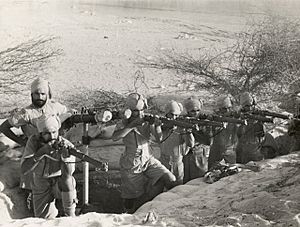
On August 11, the Italians attacked at Tug Argan. This was a key point where the road crossed the Assa hills. The British were outnumbered and outgunned. They decided to withdraw from the colony. By August 18, most British troops were evacuated by sea to Aden. The Italians entered Berbera on August 19.
The British had 38 killed and 222 wounded. The Italians had over 2,000 casualties. This battle showed the Italians' strength in the region at the start of the war.
Fighting in Anglo-Egyptian Sudan
On July 4, 1940, Italian forces from Eritrea invaded Anglo-Egyptian Sudan. They captured Kassala, an important railway junction. They also took Gallabat, a small fort near the Ethiopian border. The Italians then fortified these positions.
The British brought in the 5th Indian Division to Sudan. They formed a mobile unit called Gazelle Force to raid Italian territory.
Battle of Gallabat
On November 6, British and Indian troops attacked Gallabat. They had tanks and air support. The battle was fierce, with hand-to-hand fighting. Italian planes attacked all day, causing problems for the British. Some British troops panicked and retreated.
The British withdrew temporarily but re-occupied the fort a few days later. The fighting showed how tough the Italian defenses were. British casualties were 42 killed and 125 wounded.
Fighting in the South, 1940
British East Africa (Kenya)
When Italy declared war, the British East Africa Force prepared to defend Kenya. They aimed to stop Italian advances and tie down as many Italian troops as possible. They set up defenses along the Tana River and at key water sources.
South African, Nigerian, and Ghanaian troops joined the British forces in Kenya. By the end of 1940, about 27,000 South Africans were in East Africa. On July 1, the Italians attacked Moyale on the border with Ethiopia. After three days of fighting, the British withdrew. The Italians advanced a short distance into Kenya but stopped due to lack of supplies.
Italian Strategy Change
After conquering British Somaliland, the Italians decided to focus on defending their existing territory. Italy had suffered defeats in other parts of the war, like the Mediterranean and North Africa. So, the Italian high command ordered their forces in East Africa to move to stronger defensive positions.
This change in strategy was quickly discovered by British code-breakers. This gave the British a big advantage. They knew where the Italians were planning to move and could adjust their own plans.
Air War
The Royal Air Force (RAF) and the South African Air Force (SAAF) were active in East Africa. At first, they had older, slower planes. But later, better aircraft like Hawker Hurricanes and Gloster Gladiators arrived.
South African pilots faced experienced Italian pilots. Despite this, they claimed many enemy aircraft destroyed. Commonwealth planes constantly bombed and attacked Italian transport and troop columns. They hit supply dumps and transport, causing big fires. Italian planes also attacked British airfields, destroying some planes and fuel.
Sea War, 1940
The Red Sea was a vital shipping route for Britain. Italy's navy in Eritrea, based at Massawa, was a threat to Allied convoys. British code-breakers helped by intercepting Italian messages. This allowed the British to prepare for Italian naval actions.
The British navy set up a blockade of Italian East Africa. They also protected convoys. Italian submarines tried to attack British ships, but many were sunk or captured early in the campaign. For example, the Italian submarine Galileo Galilei was captured, and its secret documents helped the British sink other Italian submarines.
Italian destroyers also tried to attack convoys. In October, two Italian destroyers attacked a convoy but caused little damage. One Italian destroyer, Francesco Nullo, was forced aground and later bombed by the RAF. By the end of 1940, the British controlled the Red Sea. Italian forces in East Africa began to run out of fuel and supplies.
Fighting in the North, 1941
Eritrea Campaign
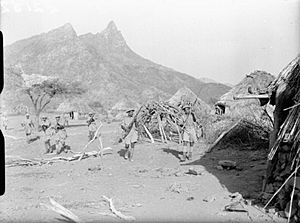
In January 1941, the Italians began to withdraw from their forward positions in Sudan. The British, knowing this from intercepted messages, started their offensive earlier than planned. They pursued the Italians into Eritrea.
Battle of Agordat and Barentu
The British 4th and 5th Indian Divisions advanced. They faced Italian rearguards. At Agordat, the British attacked with tanks and cut the road to Keren. The Italians suffered heavy losses and retreated. At Barentu, the Italians put up a strong defense, but eventually retreated as well.
Battle of Keren
The Italians set up their main defense at Keren, a mountain stronghold. This position was very strong, with tunnels and fortified areas. The British and Indian divisions attacked Keren for 53 days. It was a very tough battle.
The British captured key positions like Fort Dologorodoc. The Italians launched many counter-attacks but failed. On March 27, Keren was finally captured. British and Commonwealth forces lost 536 killed and 3,229 wounded. Italian losses were much higher, with thousands killed and wounded. The defeat at Keren broke the morale of the Italian forces.
Fall of Massawa
After Keren, the British advanced towards Massawa, Italy's main naval base in Eritrea. The Italian commander, Admiral Mario Bonetti, had 10,000 troops to defend the port. Before surrendering, the Italians tried to scuttle (sink) their ships to block the harbor.

On April 8, the British attacked Massawa. The Free French also attacked from the south-west. Italian positions fell, and Bonetti surrendered. The Allies captured 9,590 prisoners. The harbor was heavily blocked by sunken ships, but the British worked to clear it. The capture of Massawa ended the threat to shipping in the Red Sea.
Western Ethiopia Campaign
A small British and African special forces unit called Gideon Force worked with the Ethiopian Arbegnoch (Patriots). Led by Major Orde Wingate, this force operated in difficult terrain. They helped drive out Italian forces from the Gojjam Province.
Capture of Addis Ababa
As British and Commonwealth forces advanced, and the Ethiopian Patriots rose up, the Italians in Ethiopia retreated to mountain fortresses. On April 6, 1941, Addis Ababa, the Ethiopian capital, was occupied by British and South African troops. The Italian governor surrendered the city to prevent violence against Italian civilians.
Emperor Haile Selassie made a formal return to the city on May 5. British forces continued to advance north, linking up with other Allied troops.
Fighting in the South, 1941
Italian Somaliland Campaign
In January 1941, the Italians decided they could not defend the plains of Italian Somaliland. They retreated to stronger positions. The British, led by General Alan Cunningham, launched an attack called Operation Canvas.
They captured Afmadu and then the port of Kismayu. On February 22, the British attacked the main Italian position at Jelib. The Italians were defeated, with many killed, captured, or scattered. This opened the way for the British to advance to Mogadishu, the capital of Italian Somaliland.
On February 25, the 23rd Nigerian Brigade quickly moved up the coast and occupied Mogadishu without a fight. Cunningham's forces then advanced through Ethiopia towards Addis Ababa. They captured Harar and Dire Dawa in March. This allowed British forces to be supplied more easily through the port of Berbera.
Recapturing British Somaliland
The British launched Operation Appearance on March 16, 1941, to retake British Somaliland. This was the first successful Allied landing on a defended shore in the war. Troops from Aden landed at Berbera. The Italian defenders quickly retreated.
By March 20, Hargeisa was captured. The British then spent the next few months clearing out remaining Italian forces. British forces also advanced west into eastern Ethiopia, linking up with Cunningham's forces.
Battle of Amba Alagi
After the fall of Keren, the Italian commander, Duke of Aosta, retreated to Amba Alagi. This was a very strong mountain position with tunnels and fortified points. British troops from the south had already captured Addis Ababa.
The British attacked Amba Alagi in a pincer movement, with the 5th Indian Division from the south and the 1st South African Brigade from the north. The fighting was tough. On May 19, the Duke of Aosta surrendered with 5,000 Italian troops.
Southern Ethiopia Operations
In January 1941, General Cunningham's forces began attacks directly into southern Ethiopia from Kenya. They hoped to encourage local Ethiopians to rebel against the Italians. The 1st South African Division captured several towns and forts.
The advance was slowed by heavy rain in mid-February. After a three-day battle, the South Africans captured Mega on February 18.
Sea War, 1941
Controlling the seas around East Africa helped the British supply their land forces. German and Italian merchant ships were trapped in Massawa and Kismayu. Many tried to escape, but most were captured or sunk by British naval forces and aircraft.

On February 27, the Italian auxiliary cruiser Ramb I was sunk. Other Italian ships managed to escape to Japan. On April 2, five Italian destroyers tried to attack Port Sudan, but British aircraft spotted them. British planes and ships attacked, sinking three destroyers. The remaining two were abandoned and destroyed.
On April 7, an Italian motor torpedo boat torpedoed the British cruiser HMS Capetown off Massawa. The cruiser was badly damaged.
Final Operations, May–November 1941
Capture of Assab
After the surrender at Amba Alagi, some Italian forces still held out at Assab, the last Italian harbor on the Red Sea. On June 10, 1941, British Indian troops launched a surprise landing at Assab. They captured the port and its Italian commanders without a fight. This ended all Italian naval presence in the Red Sea.
Battle of Culqualber and Gondar
General Pietro Gazzera and about 15,000 Italian troops surrendered at Jimma on June 21. On July 3, Free Belgian forces defeated the Italians at Asosa and Saïo. Gazzera and his remaining troops formally surrendered on July 6.
The Wolchefit Pass was a key position needed to attack Gondar. It was defended by about 4,000 Italian soldiers. Ethiopian forces and British Indian and African troops besieged the stronghold. After losing many soldiers and running out of supplies, the Italian commander surrendered on September 28, 1941.
Gondar was the last major Italian stronghold. General Guglielmo Nasi held out for almost seven months. Italian pilots continued to fight bravely until the very end. On November 20, the last Italian fighter pilot flew a final attack mission before destroying his plane. On November 27, Nasi surrendered with 10,000 Italian and 12,000 African troops. This marked the end of organized Italian resistance in East Africa.
Aftermath
Secret Intelligence
British code-breakers played a big role in the campaign. They broke Italian military codes, which gave the British a lot of information. They knew the Italian battle plans and supply situations. This helped the British plan their attacks effectively.
Casualties
The East African campaign resulted in many casualties. By May 1941, out of about 350,000 Italian and colonial troops, around 80,000 were taken prisoner. Many more were killed or wounded.
The British and Commonwealth forces had about 1,154 battle casualties. However, they had many more cases of sickness, like dysentery and malaria. The RAF lost 138 aircraft. The Italian air force lost most of its planes. Belgian forces also suffered hundreds of fatalities.
Later Operations
After November 1941, small groups of Italian soldiers continued a guerrilla war until September 1943. They hoped for help from Germany or Japan. Some notable Italian officers led these groups. Hostilities officially ended when Italy surrendered to the Allies in September 1943.
Post-War Changes
In January 1942, Britain recognized Ethiopia's independence. Eritrea was placed under British control and later became part of Ethiopia in 1950. After 1945, Britain controlled both Somalilands. In 1949, the United Nations gave Italy control of Italian Somaliland again, but only for ten years, with the condition that it would become independent.
British Somaliland became independent in June 1960. Italian Somaliland became independent in July 1960. The two territories then united to form the Somali Republic.
Victoria Cross
The Victoria Cross is the highest award for bravery in the British military. Here are some who received it during this campaign:
- Eric Charles Twelves Wilson (captain, Somaliland Camel Corps) – For bravery during the Italian invasion of British Somaliland.
- Premindra Singh Bhagat (second lieutenant, Royal Bombay Sappers and Miners) – For actions on the Northern Front.
- Richhpal Ram (Subedar in 6th Rajputana Rifles) – Received after his death for fighting on the Northern Front.
- Nigel Leakey (sergeant in the 1/6 Battalion King's African Rifles) – Received after his death for fighting on the Southern Front.
Images for kids
-
Indian soldiers at a shore post in Berbera, August 1940.
-
Indian troops clearing a village in Eritrea, 1941.
-
Indian Army on the road to Asmara, c. May 1941
-
Italian ship Ramb I sinking, 1941
See also
- List of British military equipment of World War II
- List of Second Italo-Ethiopian War weapons of Ethiopia - Arbegnoch used Ethiopian and captured Italian weapons
- List of Belgian military equipment of World War II
- List of French military equipment of World War II
- List of Italian Army equipment in World War II
- Italian guerrilla war in Ethiopia
- Woyane rebellion
- Italian Empire
- Colonial heads of Italian East Africa
- Military history of Ethiopia
- Military production during World War II
- Military history of Italy during World War II
- North African campaign
- Western Desert campaign
- Syria-Lebanon campaign
- West Africa campaign
- Battle of Madagascar
- German Motorized Company
- MVSN Colonial Militia
- South African Irish Regiment
- 81st (West Africa) Division
- 82nd (West Africa) Division
- Royal Corps of Colonial Troops
- Dubats
- Zaptie
- Armoured car regiment



